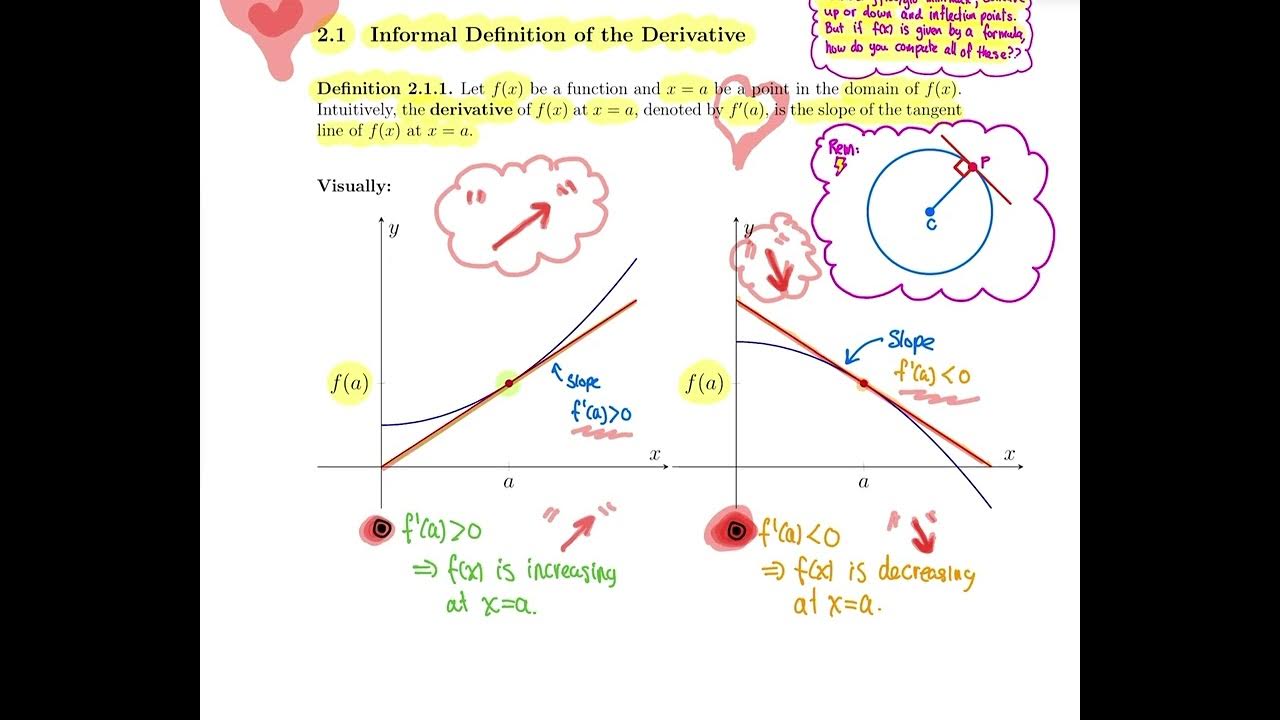Derivative definition
Summary
TLDRThe video script introduces the concept of the derivative of a single-variable function, emphasizing its definition and various notations. It explains the derivative as the limit of the difference quotient as Δx approaches zero, denoted by a prime symbol or Leibniz's dy/dx notation. An example illustrates calculating the instantaneous rate of change, showing how to find the derivative at a specific point and the derivative function. The script concludes by highlighting the importance of understanding different derivative notations for practical applications.
Takeaways
- 📘 The derivative of a function f at a point x_0 is defined as the limit of the difference quotient as Δx approaches 0.
- 🖊 The derivative is denoted by a prime symbol, such as f'(x_0), indicating the rate of change at a specific point.
- 🌱 An example using the derivative is provided with the growth rate of a plant, where the height function is given by h(x) = 2x + 3, and the derivative at 30 days is calculated.
- 📈 The derivative function f'(x) is a generalization that allows for finding the derivative at any point by substituting x_0 with a variable.
- 🔢 The process to find the derivative function involves taking the limit of the difference quotient for a given function, as demonstrated with f(x) = 3x^2.
- 📐 The derivative function for 3x^2 is found to be 6x, showcasing the simplification and cancellation of terms in the limit process.
- 📝 Three notations for the derivative are introduced: prime notation, Leibniz notation (dy/dx), and operator notation (Dx).
- 📋 Prime notation is used to denote both the derivative function and the derivative at a specific point, with the latter indicated by specifying the point.
- 📏 Leibniz notation emphasizes the rate of change, using differentials (dy and dx) instead of differences, and is useful for understanding the derivative as an instantaneous rate of change.
- 🛠 Operator notation uses Dx to denote the derivative, providing a compact way to express the derivative operation.
Q & A
What is the definition of the derivative of a function at a point?
-The derivative of a function f at a point x0 is given by the limit as Δx approaches 0 of (f(x0 + Δx) - f(x0)) / Δx.
What does the prime notation represent in calculus?
-The prime notation, denoted as f', represents the derivative of a function f at a specific point x0.
How is the instantaneous rate of change related to the derivative?
-The instantaneous rate of change at a point x0 is represented by the derivative of the function at that point, which is the same formula used to define the derivative.
What is an example provided in the script to illustrate the concept of a derivative?
-An example given is the growth of a plant over time, where the height of the plant is represented by the function h(x) = 2x + 3, and the derivative is used to find the rate of growth after 30 days.
What does the derivative of the function h(x) = 2x + 3 at x = 30 equal to?
-The derivative of h(x) at x = 30 is 2, indicating the plant's height is growing at a rate of 2 units per day after one month.
Why is it beneficial to define a derivative function instead of calculating the derivative at a specific point?
-Defining a derivative function allows for a more efficient calculation of the derivative at any point of interest by simply plugging in the value of x, rather than recalculating the entire derivative each time.
What is the derivative function of f(x) = 3x^2?
-The derivative function of f(x) = 3x^2 is f'(x) = 6x, which can be found by applying the definition of the derivative with x as a variable.
What are the three different notations for the derivative introduced in the script?
-The three notations for the derivative are: prime notation (f'), Leibniz notation (dy/dx), and operator notation (D_x).
How does Leibniz notation for the derivative differ from the prime notation?
-Leibniz notation uses dy/dx to represent the derivative function, and dy/dx evaluated at x = x0 is denoted by placing a vertical bar (dy/dx)|x=x0 to indicate the derivative at a specific point.
What is the significance of the operator notation for the derivative?
-Operator notation, denoted by D_x, signifies the action of taking the derivative of a function and can be used to indicate the derivative evaluated at a point by adding a vertical bar (D_x)|x=x0.
What is the main takeaway from the script regarding derivatives?
-The main takeaway is the formal definition of a derivative function and the derivative at a single point, along with an understanding of the three common notations used to represent derivatives.
Outlines

Dieser Bereich ist nur für Premium-Benutzer verfügbar. Bitte führen Sie ein Upgrade durch, um auf diesen Abschnitt zuzugreifen.
Upgrade durchführenMindmap

Dieser Bereich ist nur für Premium-Benutzer verfügbar. Bitte führen Sie ein Upgrade durch, um auf diesen Abschnitt zuzugreifen.
Upgrade durchführenKeywords

Dieser Bereich ist nur für Premium-Benutzer verfügbar. Bitte führen Sie ein Upgrade durch, um auf diesen Abschnitt zuzugreifen.
Upgrade durchführenHighlights

Dieser Bereich ist nur für Premium-Benutzer verfügbar. Bitte führen Sie ein Upgrade durch, um auf diesen Abschnitt zuzugreifen.
Upgrade durchführenTranscripts

Dieser Bereich ist nur für Premium-Benutzer verfügbar. Bitte führen Sie ein Upgrade durch, um auf diesen Abschnitt zuzugreifen.
Upgrade durchführenWeitere ähnliche Videos ansehen

Applying First Principles to x² (1 of 2: Finding the Derivative)

Calculus- Lesson 8 | Derivative of a Function | Don't Memorise

01. Derivative using definition as limit

ADM1305 - Section 2.1 and Section 2.2

Konsep Limit Matematika dalam Kehidupan Sehari-Hari - Kelas 12 SMA

Limits, L'Hôpital's rule, and epsilon delta definitions | Chapter 7, Essence of calculus
5.0 / 5 (0 votes)
